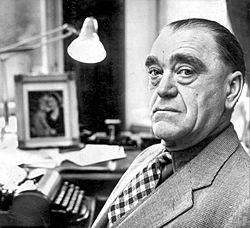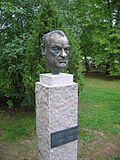Vilhelm Moberg facts for kids
Karl Artur Vilhelm Moberg (born August 20, 1898 – died August 8, 1973) was a famous Swedish journalist, author, playwright, historian, and public speaker. He wrote for over 45 years. He is best known for his series of books called The Emigrants.
These four books, published between 1949 and 1959, tell the story of Swedish people moving to the United States in the 1800s. These books were so popular that they were made into two movies and a musical! Moberg also wrote other important books like Raskens (1927) and Ride This Night (1941). Ride This Night was a historical novel about a rebellion in Sweden in the 1600s. Many people saw it as a hidden criticism of the Hitler government.
Vilhelm Moberg was a well-known public figure in Sweden. He often spoke out against things he thought were wrong. He was critical of the Swedish monarchy (the royal family), believing that the government should be run by the people, like a confederal republic (a country without a king or queen). He also strongly spoke out against the policies of Nazi Germany, the Greek military junta (a military government), and the Soviet Union. Some of his books were even destroyed in Nazi book burnings because of his views.
Contents
Early Life and Education
Vilhelm Moberg was born in 1898 on a farm near Emmaboda in southern Sweden. He was the fourth of six children, but only three of them lived to be adults. His family members before him were soldiers and small farmers. For the first nine years of his life, he lived in a small soldier's cottage. His father, Karl Moberg, was a soldier who took over the cottage in 1888.
In 1907, his family moved to a small farm that used to belong to his mother's family. They had lost it because they were poor. But money from his mother's family in America helped them buy it back. Vilhelm Moberg only went to school for a short time, from 1906 to 1912. However, he loved to read as a child and published his first writing when he was just 13 years old.
Before becoming a writer, Moberg worked as a farmer, a forest worker, and even in glassblowing. In 1916, he almost moved to the United States to join his aunt and uncle, but he decided to stay in Sweden with his parents. Moberg mostly taught himself, but he did study at two schools: Kronoberg County Folk High School (1916-1917) and Katrineholms Praktiska Skola (1917-1918). In 1918, he got very sick with the Spanish flu and was ill for six months. After he recovered, Moberg worked for a newspaper called Vadstena Läns Tidning. This newspaper published many of his stories between 1919 and 1929.
In 1926, Moberg became well-known as a playwright when his comedy Kassabrist was very successful in Stockholm. He published his first novel, Raskens, the next year. The success of Raskens allowed Moberg to become a full-time writer.
A Famous Writer
Many of Vilhelm Moberg's books have been translated into English. People around the world who are interested in Scandinavian culture and history know his work. In his book A Soldier with a Broken Rifle, which is about his own life, he wrote about how important it is to give a voice to people who are not usually heard, like the poor and those who couldn't read.
This idea also shaped his book History of the Swedish People, I-II, published in 1970–71. He wanted to write more volumes of this history, but he was not able to finish it.
As a playwright, Moberg wrote 38 plays for the stage or for radio between 1919 and 1973. Some of these plays became popular in Sweden and were even made into movies by famous directors like Ingmar Bergman and Alf Sjöberg.
Speaking Up for Justice
Moberg joined a young Social Democrats club in 1913. In his books and public talks, he often shared his belief that Sweden should be a republic, not a monarchy. He felt this way because of certain events where he believed the monarchy was involved in unfair situations. Moberg actively worked to help regular people who had faced unfair treatment.
Like other Swedish writers from his time who grew up in working-class families, Moberg wrote about the lives of people who were poor or didn't have much power. He showed their traditions, customs, and their daily struggles. His novels are important because they show us what life was like in Sweden and how different social and political ideas influenced people.
The Emigrants Series
Moberg's most famous work is The Emigrants series of four novels. He wrote them between 1949 and 1959. These books tell the story of a Swedish family moving from Småland to Chisago County, Minnesota in the mid-1800s. This was a journey taken by almost one million Swedish people, including some of Moberg's own relatives.
Books About New Beginnings
These novels have been translated into English:
- The Emigrants (1951)
- Unto a Good Land (1954)
- The Settlers (1961)
- The Last Letter Home (1961)
Moberg lived in Carmel-by-the-Sea, California from 1948 to 1960. He wrote his popular The Emigrants series while living there. The Vilhelm Moberg House is located in Carmel Point.
Movies and a Musical
Swedish film director Jan Troell made two major movies based on the books in 1971-72. They were called The Emigrants and The New Land. Famous actors Max von Sydow and Liv Ullmann played the main characters, Karl Oskar and Kristina. These movies were nominated for several Academy Awards, and The New Land won Golden Globe Awards.
A musical called Kristina från Duvemåla (English title Kristina) was created in 1995. It was written by Björn Ulvaeus and Benny Andersson, who were members of the famous music group ABBA. This musical is also based on Moberg's The Emigrants Series. Many of Moberg's other works have also been made into films and TV series in Sweden over the years.
His Legacy
Moberg gave his important papers to the Swedish Emigrant Institute in Växjö, Sweden. The institute has a special "Moberg Room" where visitors can see his original writings, notes, and photos. It feels like you are meeting Vilhelm Moberg in his own workspace! This collection also includes a sculpture called The Emigrants, which shows the main characters from his famous series. The Vilhelm Moberg Society works to promote his books, research, and general interest in his works.
Later Life
In his final years, Vilhelm Moberg faced personal challenges. He was buried in Norra begravningsplatsen in Stockholm.
Works in English
The Emigrants Books
- The Emigrants (1949), ISBN: 0-87351-319-3.
- Unto a Good Land (1952), ISBN: 0-87351-320-7.
- The Settlers (1956), ISBN: 0-87351-321-5.
- The Last Letter Home (1959), ISBN: 0-87351-322-3.
Other Stories
- Memory of Youth
- Ride This Night
- A Time on Earth, ISBN: 1-56849-314-2.
- When I Was a Child, ISBN: 0-8488-0302-7.
Non-Fiction Books
- A History of the Swedish People, Vol. 1: From Prehistory to the Renaissance, ISBN: 0-8166-4656-2.
- A History of the Swedish People, Vol. 2: From Renaissance to Revolution, ISBN: 0-8166-4657-0. Both volumes translated by Paul Britten Austin.
- The Unknown Swedes: A Book About Swedes and America, Past and Present, ISBN: 0-8093-1486-X.
Images for kids
See also
 In Spanish: Vilhelm Moberg para niños
In Spanish: Vilhelm Moberg para niños





